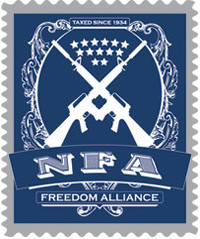Is engraving NFA items really required when filing a Form 1?
Unfortunately this can be argued both ways and very often is in the NFA community. The short answer is YES. The longer answer is below.As outlined in the Code of Federal Regulations
§479.102 How must firearms be identified?
(a) You, as a manufacturer, importer, or maker of a firearm, must legibly identify the firearm as follows:
(1) By engraving, casting, stamping (impressing), or otherwise conspicuously placing or causing to be engraved, cast, stamped (impressed) or placed on the frame or receiver thereof an individual serial number. The serial number must be placed in a manner not susceptible of being readily obliterated, altered, or removed, and must not duplicate any serial number placed by you on any other firearm. For firearms manufactured, imported, or made on and after January 30, 2002, the engraving, casting, or stamping (impressing) of the serial number must be to a minimum depth of .003 inch and in a print size no smaller than 1⁄16 inch; and
(2) By engraving, casting, stamping (impressing), or otherwise conspicuously placing or causing to be engraved, cast, stamped (impressed), or placed on the frame, receiver, or barrel thereof certain additional information. This information must be placed in a manner not susceptible of being readily obliterated, altered or removed. For firearms manufactured, imported, or made on and after January 30, 2002, the engraving, casting, or stamping (impressing) of this information must be to a minimum depth of .003 inch. The additional information includes:
(i) The model, if such designation has been made;
(ii) The caliber or gauge;
(iii) Your name (or recognized abbreviation) and also, when applicable, the name of the foreign manufacturer or maker;
(iv) In the case of a domestically made firearm, the city and State (or recognized abbreviation thereof) where you as the manufacturer maintain your place of business, or where you, as the maker, made the firearm; and
(v) In the case of an imported firearm, the name of the country in which it was manufactured and the city and State (or recognized abbreviation thereof) where you as the importer maintain your place of business. For additional requirements relating to imported firearms, see Customs regulations at 19 CFR part 134.
(b) The depth of all markings required by this section will be measured from the flat surface of the metal and not the peaks or ridges. The height of serial numbers required by paragraph (a)(1) of this section will be measured as the distance between the latitudinal ends of the character impression bottoms (bases).
(c) The Director may authorize other means of identification upon receipt of a letter application from you, submitted in duplicate, showing that such other identification is reasonable and will not hinder the effective administration of this part.
(d) In the case of a destructive device, the Director may authorize other means of identifying that weapon upon receipt of a letter application from you, submitted in duplicate, showing that engraving, casting, or stamping (impressing) such a weapon would be dangerous or impracticable.
(e) A firearm frame or receiver that is not a component part of a complete weapon at the time it is sold, shipped, or otherwise disposed of by you must be identified as required by this section.
(f)(1) Any part defined as a machine gun, muffler, or silencer for the purposes of this part that is not a component part of a complete firearm at the time it is sold, shipped, or otherwise disposed of by you must be identified as required by this section.
(2) The Director may authorize other means of identification of parts defined as machine guns other than frames or receivers and parts defined as mufflers or silencers upon receipt of a letter application from you, submitted in duplicate, showing that such other identification is reasonable and will not hinder the effective administration of this part.
Now the argument is...
The reason this all gets a little murky is that when you file a Form 1 to register an existing firearm as an NFA item it already possesses all of those necessary markings. The logic is that since it already exists as a firearm fully marked in compliance with those requirements there is no reason for additional engravings to be made to the firearm. While this makes LOGICAL sense the ATF isn't exactly known for using logic or common sense. A further argument can be made that, in accordance with the manufacture of Title I firearms for personal use (things like 80% receiver, AKs from receiver flats, and similar examples), there is no requirement for markings of any kind under federal law. If at any point you sell those weapons manufactured for personal use (which is also legal) they would be required at that time to be marked in compliance to the engraving requirements listed above. Taking that a step further it makes sense that the engravings would only be needed if you were to sell your Form 1 SBR down the road. Trouble there is that once again the ATF doesn't make sense.
The simple answer is, to avoid any confusion or uneccessary risk, engrave your NFA items. Always engrave them. Always.





